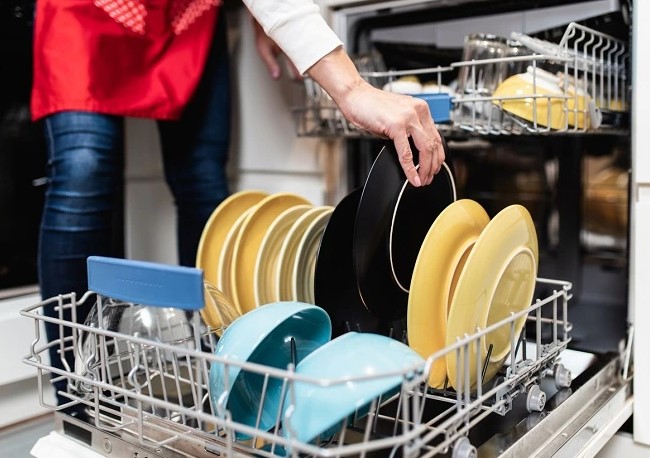Factors to Consider When Choosing a Portable Dishwasher
Portable dishwashers offer a convenient solution for those with limited kitchen space or rental properties. These compact appliances provide the benefits of a full-sized dishwasher without the need for permanent installation. Factors to consider when choosing a portable dishwasher, some important factors need to be considered to ensure you choose the most suitable model for your needs.
In this comprehensive guide, we will explore the key aspects to evaluate when purchasing a portable dishwasher. We’ll delve into size and capacity considerations, water and electricity requirements, essential features and functionality, budget constraints, brand reputation, user feedback, and installation and maintenance concerns. By thoroughly examining these factors, you’ll be well-equipped to make an informed decision and select a portable dishwasher that seamlessly integrates into your lifestyle and kitchen setup.
Size and Capacity: Finding the Perfect Fit
The size and capacity of a portable dishwasher play a pivotal role in its effectiveness and convenience. Portable dishwashers typically range from 18 to 24 inches in width, with capacities varying from 6 to 12 place settings. To determine the ideal size for your needs, consider the following:
1. Available space: Measure the area where you plan to store and use the dishwasher, ensuring adequate clearance for door opening and hose connections.
2. Household size: Larger families or frequent entertainers may require a higher capacity model to avoid multiple wash cycles.
3. Dish volume: Assess your typical dish load to ensure the chosen capacity can accommodate your needs.
A compact 18-inch model may suffice for small apartments or couples, while a larger 24-inch unit might be more suitable for families or those who frequently host gatherings. Remember that portable dishwashers often have slightly lower capacities than their built-in counterparts, so adjust your expectations accordingly.
Water and Electricity Connection: Ensuring Compatibility

Understanding the water and electricity requirements of a portable dishwasher is crucial for seamless operation. Most portable dishwashers connect to a standard kitchen faucet using an adapter, while some models may require a dedicated water line. Consider the following aspects:
1. Water hookup: Ensure your faucet is compatible with the dishwasher’s adapter or consider professional installation for a dedicated line.
2. Water pressure: Verify that your home’s water pressure meets the minimum requirements specified by the manufacturer.
3. Electrical needs: Most portable dishwashers operate on standard 120-volt outlets, but confirm the voltage and amperage requirements before purchase.
4. Cord length: Check the power cord length to ensure it reaches the nearest outlet without requiring an extension cord.
It’s essential to evaluate your kitchen’s infrastructure to determine if any modifications are necessary to accommodate the portable dishwasher’s water and electrical needs.
Features and Functionality: Enhancing Your Dishwashing Experience
When choosing a portable dishwasher, the features and functionality it offers can significantly impact its performance and convenience. Consider the following key aspects:
1. Wash cycles: Look for models with a variety of cycles, including normal, heavy-duty, and eco-friendly options.
2. Temperature settings: Adjustable water temperature settings allow for customized cleaning based on dish type and soil level.
3. Drying options: Some models offer heated drying, while others rely on air drying or a combination of both.
4. Noise level: Check the decibel rating to ensure the dishwasher won’t disrupt your living space.
5. Energy efficiency: Look for ENERGY STAR-certified models to reduce water and electricity consumption.
Additional features to consider include:
– Adjustable racks for accommodating larger items
– Delay start function for convenient scheduling
– Soil sensors for optimized wash cycles
– Child lock for safety
Table: Common Features in Portable Dishwashers
| Feature | Description | Importance |
|---|---|---|
| Multiple wash cycles | Variety of cleaning options | High |
| Adjustable temperature | Customizable water heat | Medium |
| Heated drying | Faster, more thorough drying | Medium |
| Noise reduction | Quieter operation | High |
| Energy efficiency | Reduced utility costs | High |
| Adjustable racks | Flexibility for various dish sizes | Medium |
| Delay start | Convenient scheduling | Low |
| Soil sensors | Optimized cleaning | Medium |
| Child lock | Safety feature | Low |
Budget and Brand Reputation: Balancing Cost and Quality

When considering Factors to Consider When Choosing a Portable Dishwasher, budget and brand reputation play crucial roles in the decision-making process. Portable dishwashers typically range from $300 to $1000, with price variations reflecting differences in capacity, features, and brand prestige. Establish a realistic budget based on your needs and financial constraints, but remember that investing in a higher-quality model may yield long-term benefits in terms of durability and performance.
Research reputable brands known for producing reliable portable dishwashers. Some well-regarded manufacturers include:
– KitchenAid: Known for compact, affordable models
– GE: Offers a range of features and sizes
– Whirlpool: Recognized for reliability and performance
– SPT: Specializes in compact appliances
– EdgeStar: Focuses on space-saving designs
Each brand has its strengths and weaknesses, so consider reading expert reviews and consumer reports to gain insights into their performance, customer service, and overall value.
Reviews and User Feedback: Learning from Others’ Experiences

Gathering information from reviews and user feedback is an invaluable step in choosing the right portable dishwasher. These real-world experiences can provide insights into aspects that may not be apparent from manufacturer specifications alone. Consider the following when researching reviews:
1. Seek out reviews from reputable sources, such as consumer advocacy organizations and trusted technology review websites.
2. Read a mix of positive and negative reviews to gain a balanced perspective on each model’s strengths and weaknesses.
3. Pay attention to recurring themes in user feedback, such as ease of use, cleaning performance, and durability.
4. Look for reviews from users with similar household sizes and dishwashing needs to your own.
5. Consider the date of the reviews, as newer models may have addressed issues present in earlier versions.
Remember that while reviews can be helpful, individual experiences may vary. Use this information as a guide rather than the sole basis for your decision.
Installation and Maintenance: Ensuring Longevity and Performance
The installation process for portable dishwashers is generally straightforward, but it’s essential to consider any potential challenges or requirements. Most models come with detailed instructions and necessary hardware for setup. Key installation considerations include:
1. Proximity to water source and electrical outlet
2. Adequate space for maneuvering the unit
3. Proper leveling to ensure optimal performance
4. Secure connections for water inlet and drain hoses
Regular maintenance is crucial for preserving your portable dishwasher’s performance and extending its lifespan. Consider the following maintenance tips:
– Clean the filter and spray arms regularly to prevent clogs and ensure efficient cleaning
– Inspect and clean the door seal to prevent leaks
– Run an empty cycle with vinegar or a dishwasher cleaner monthly to remove buildup
– Check and tighten hose connections periodically
– Address any unusual noises or performance issues promptly
By following these maintenance practices, you can ensure your portable dishwasher continues to operate efficiently for years to come.
In conclusion
Selecting the ideal portable dishwasher requires careful consideration of various factors, including size and capacity, water and electricity requirements, features and functionality, budget constraints, brand reputation, user feedback, and installation and maintenance needs. By thoroughly evaluating these aspects and aligning them with your specific requirements, you can confidently choose a portable dishwasher that enhances your kitchen efficiency and simplifies your daily routine. If you’re exploring top options, researching the best KitchenAid dishwasher models can also provide valuable insights into high-performing choices that meet your needs. Remember that the perfect portable dishwasher is one that seamlessly integrates into your lifestyle while providing reliable and effective cleaning performance.

Michael Thompson is a highly skilled appliance technician specializing in KitchenAid dishwashers. With many years of experience, Michael is renowned for his expertise in handling various models of KitchenAid dishwashers, ensuring optimal performance and longevity. His dedication to customer satisfaction and in-depth knowledge of appliance technology make him a trusted figure in his community. Michael’s commitment to quality service has earned him a reputation as one of the best in his field.






This article is incredibly helpful for selecting a portable dishwasher! The tips on evaluating features like size, capacity, and installation options are very practical. I especially appreciated the advice on how to match the dishwasher with your kitchen space. Thanks for the great guidance!
Great guide on choosing a portable dishwasher! The detailed breakdown of factors such as water usage, energy efficiency, and noise level is very informative. I found the tips on portability and ease of use particularly useful. This guide has been very helpful for my dishwasher search.
Excellent guide on choosing a portable dishwasher! The section on water connection options was very helpful. Could you provide more tips on what to consider if my sink doesn’t have a standard connection?
Hi Olivia,
Thank you for your feedback! I’m glad you found the guide helpful. If your sink doesn’t have a standard connection, here are a few additional tips:
Adapter Compatibility: Check if there are adapter kits available that can help you connect a portable dishwasher to non-standard sink fixtures. These kits often include various fittings to match different types of connections.
Installation Options: Consider a portable dishwasher that comes with flexible installation options, such as a faucet adapter or a hose that can accommodate various sink configurations.
Professional Help: If you’re unsure about the installation, it might be worth consulting a plumber. They can help you identify the best solution and ensure a proper connection.
Sink Aerator Removal: Some portable dishwashers require the removal of the sink aerator to connect. Make sure to check the manufacturer’s instructions to see if this is necessary and if your sink’s aerator can be easily removed.
Alternative Solutions: If adapting your sink proves challenging, you might also consider a built-in dishwasher that could be a better fit for your setup.
I hope these tips help! Feel free to ask if you have any more questions.
Best regards,
Can you elaborate on how to evaluate the energy efficiency of a portable dishwasher? What are the key features to look for to ensure it’s energy-saving?
Hi Janncomeau
To evaluate the energy efficiency of a portable dishwasher, consider the following key features:
Energy Star Rating: Look for dishwashers with an Energy Star certification. This label indicates that the appliance meets strict energy efficiency guidelines set by the U.S. Environmental Protection Agency (EPA).
Energy Consumption: Check the dishwasher’s energy consumption, usually listed in kWh per year. Lower consumption figures typically mean the appliance is more energy-efficient.
Wash Cycles and Modes: Opt for models with multiple wash cycles and eco-friendly modes. These settings allow you to choose a cycle that matches the load size and dirt level, reducing energy use when possible.
Water Heating Efficiency: Some dishwashers have built-in heaters that are more energy-efficient than using your home’s hot water supply. Look for models with high-efficiency water heaters.
Delay Start Feature: This allows you to run the dishwasher during off-peak energy hours, which can be beneficial if your energy provider offers lower rates during those times.
By paying attention to these features, you can choose a portable dishwasher that is both energy-saving and cost-effective.
What should I look for in terms of noise levels when choosing a portable dishwasher? How can I ensure it will operate quietly in a small living space?
Hi! Jessica Taylor
When choosing a portable dishwasher for a small living space, noise levels are definitely an important factor. Most dishwashers measure noise in decibels (dB), and you’ll generally want to look for a model that’s below 50 dB for quiet operation. Anything under 45 dB is considered very quiet—comparable to the sound of light rainfall.
To ensure quiet operation, you can check for dishwashers that specifically advertise low-noise features, such as sound insulation or quieter motors. Additionally, consider looking for user reviews that mention how the dishwasher performs in terms of noise, as real-world experiences can give you a better idea of how it will sound in your space.
If you’re sensitive to noise or live in a small apartment, opting for a model with a delayed start feature can also be helpful, allowing you to run it during times when noise won’t be as disruptive.